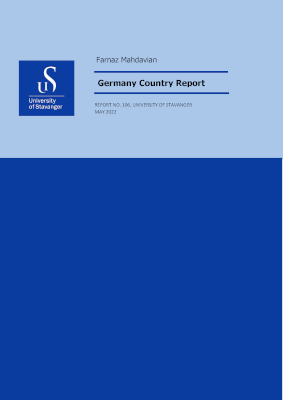Germany Country Report
Keywords:
Germany, Covid-19, pandemic response, risk communication, PAN-FIGHTSynopsis
Product of the research project Fighting pandemics with enhanced risk communication: Messages, compliance and vulnerability during the COVID-19 outbreak (PAN-FIGHT). Other PAN-FIGHT reports published by UiS: United Kingdom Country Report, Switzerland Country Report and Sweden Country Report.
Germany is a parliamentary democracy (The Federal Government, 2021) with two politically independent levels of 1) Federal (Bund) and 2) State (Länder or Bundesländer), and has a highly differentiated decentralized system of Government and administration (Deutsche Gesellschaft für Internationale Zusammenarbeit, 2021). The 16 states in Germany have their own government and legislations which means the federal authority has the responsibility of formulating policy, and the states are responsible for implementation (Franzke, 2020). The Federal Government supports the states in dealing with extraordinary danger and the Federal Ministry of the Interior (BMI) supports the states' operations with technology, expertise and other services (Federal Ministry of Interior, Building and Community, 2020). Due to the decentralized system of government, the Federal Government does not have the power to impose pandemic emergency measures. In the beginning of the COVID-19 pandemic, in order to slowdown the spread of coronavirus, on 16 March 2020 the federal and state governments attempted to harmonize joint guidelines, however one month later State governments started to act more independently (Franzke & Kuhlmann, 2021).
In Germany, health insurance is compulsory and more than 11% of Germany’s GDP goes into healthcare spending (Federal Statistical Office, 2021). Health related policy at the federal level is the primary responsibility of the Federal Ministry of Health. This ministry supervises institutions dealing with higher level of public health including the Federal Institute for Drugs and Medical Devices (BfArM), the Paul-Ehrlich-Institute (PEI), the Robert Koch Institute (RKI) and the Federal Centre for Health Education (Federal Ministry of Health, 2020).
The first German National Pandemic Plan (NPP), published in 2005, comprises two parts. Part one, updated in 2017, provides a framework for the pandemic plans of the states and the implementation plans of the municipalities, and part two, updated in 2016, is the scientific part of the National Pandemic Plan (Robert Koch Institut, 2017).
The joint Federal-State working group on pandemic planning was established in 2005. A pandemic plan for German citizens abroad was published by the German Foreign Office on its website in 2005 (Robert Koch Institut, 2017). In 2007, the federal and state Governments, under the joint leadership of the Federal Ministry of the Interior and the Federal Ministry of Health, simulated influenza pandemic exercise called LÜKEX 07, and trained cross-states and cross-department crisis management (Bundesanstalt Technisches Hilfswerk, 2007b). In 2017, within the context of the G20, Germany ran a health emergency simulation exercise with representatives from WHO and the World Bank to prepare for future pandemic events (Federal Ministry of Health et al., 2017).
By the beginning of the COVID-19 pandemic, on 27 February 2020, a joint crisis team of the Federal Ministry of the Interior (BMI) and the Federal Ministry of Health (BMG) was established (Die Bundesregierung, 2020a). On 4 March 2020 RKI published a Supplement to the National Pandemic Plan for COVID-19 (Robert Koch Institut, 2020d), and on 28 March 2020, a law for the protection of the population in an epidemic situation of national scope (Infektionsschutzgesetz) came into force (Bundesgesundheitsministerium, 2020b).
In the first early phase of the COVID-19 pandemic in 2020, Germany managed to slow down the speed of the outbreak but was less successful in dealing with the second phase. Coronavirus-related information and measures were communicated through various platforms including TV, radio, press conferences, federal and state government official homepages, social media and applications.
In mid-March 2020, the federal and state governments implemented extensive measures nationwide for pandemic containment. Step by step, social distancing and shutdowns were enforced by all Federal States, involving closing schools, day-cares and kindergartens, pubs, restaurants, shops, prayer services, borders, and imposing a curfew. To support those affected financially by the pandemic, the German Government provided large economic packages (Bundesministerium der Finanzen, 2020). These measures have adopted to the COVID-19 situation and changed over the pandemic. On 22 April 2020, the clinical trial of the corona vaccine was approved by Paul Ehrlich Institute, and in late December 2020, the distribution of vaccination in Germany and all other EU countries


